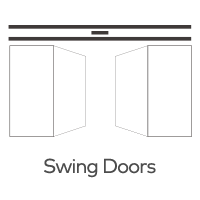What is an automatic sliding door controller, and how does it function?
In the realm of modern building design and convenience, automatic sliding doors have become a ubiquitous feature. Seamlessly opening and closing in response to approaching individuals, they enhance accessibility and efficiency in various settings. Behind the smooth operation of these doors lies a crucial component: the automatic sliding door controller. In this article, we delve into what an automatic sliding door controller is and how it functions.

Understanding the Automatic Sliding Door Controller:
An automatic sliding door controller is a sophisticated electronic device that regulates the movement of sliding doors, allowing them to open and close automatically. It serves as the brain of the operation, orchestrating the synchronized actions of the door's various components.
Components of an Automatic Sliding Door Controller System:
1. Controller Unit: At the heart of the system is the controller unit, a central processing unit that receives inputs from various sensors and controls the operation of the door.
2. Motion Sensors: Typically, automatic sliding doors are equipped with motion sensors, such as infrared or microwave sensors. These sensors detect the presence of individuals approaching the door.
3. Door Panels: The door panels themselves are equipped with motors or actuators that enable their movement. These motors are controlled by the automatic sliding door controller.
4. Safety Sensors: To prevent accidents and collisions, safety sensors are integrated into the door's design. These sensors can detect obstacles in the door's path and prompt the controller to halt or reverse the door's movement.
5. Activation Devices: Activation devices include push buttons, remote controls, or touchless sensors that allow users to initiate the door's opening.
Functionality of the Automatic Sliding Door Controller:
1. Sensing Approach: When a person approaches the door, the motion sensors detect the motion or presence, sending a signal to the automatic sliding door controller.
2. Signal Processing: The controller processes the sensor signal and determines whether the door needs to open. Factors like direction, speed, and safety measures are taken into account.
3. Command Transmission: Once the decision is made to open the door, the controller sends commands to the door's motor, initiating the opening process.
4. Smooth Operation: The motor moves the door panels along the track, ensuring a smooth and controlled opening motion. Safety sensors continually monitor for obstacles.
5. Time and Distance Control: The controller calculates the duration and distance the door needs to open based on the sensor input. It ensures the door remains open long enough for safe passage.
6. Closing Sequence: After a predefined time or when no more motion is detected, the controller commands the door to close. Again, safety sensors ensure the path is clear.
7. Emergency Stop: If an obstruction is detected during closure, safety sensors halt the door's movement and trigger a reverse action to prevent accidents.
Benefits of Automatic Sliding Door Controllers:
Accessibility: These controllers enhance accessibility for people with disabilities or those carrying heavy objects.
Convenience: Automatic sliding doors provide hands-free operation, particularly useful when entering with bags or strollers.
Energy Efficiency: The controlled opening and closing reduce the escape of conditioned air, contributing to energy savings.
Safety: Safety sensors prevent collisions, reducing the risk of accidents.
Aesthetics: Automatic sliding doors lend a modern, sleek look to buildings and entrances.
Conclusion: Technology in Motion
The automatic sliding door controller is a pivotal element in the seamless functioning of modern entrances. It marries technology and convenience, creating a harmonious interface between humans and architecture. With the ability to sense, process, and execute precise movements, these controllers contribute to a safer, more accessible, and efficient built environment.







